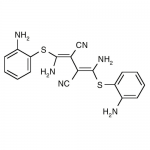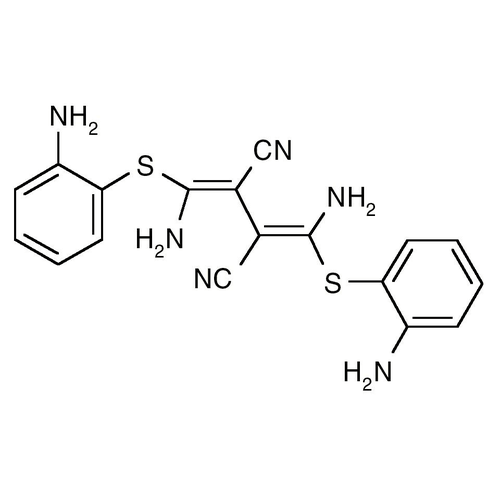| Product Name | U-0126 |
| Description |
MEK inhibitor |
| Purity | >98% |
| CAS No. | 109511-58-2 |
| Molecular Formula | C18H16N6S2 |
| Molecular Weight | 380.5 |
| Field of Use | Not for use in humans. Not for use in diagnostics or therapeutics. For in vitro research use only. |
Properties
| Storage Temperature | -20ºC |
| Shipping Temperature | Shipped Ambient |
| Product Type | Inhibitor |
| Solubility | Soluble in DMSO (>10 mg/ml), 100% ethanol (2 mg/ml) |
| Source | Synthetic |
| Appearance | White solid |
| SMILES | C2=C(SC(/N)=C(/C(=C(SC1=CC=CC=C1N)N)C#N)C#N)C(=CC=C2)N |
| InChI | InChI=1S/C18H16N6S2/c19-9-11(17(23)25-15-7-3-1-5-13(15)21)12(10-20)18(24)26-16-8-4-2-6-14(16)22/h1-8H,21-24H2/b17-11+,18-12+ |
| InChIKey | DVEXZJFMOKTQEZ-JYFOCSDGSA-N |
| Safety Phrases |
Classification: Caution: Substance not yet fully tested. Safety Phrases: S22 - Do not breathe dust. S24/25 - Avoid contact with skin and eyes S36/37/39 - Wear suitable protective clothing, gloves and eye/face protection |
| Cite This Product | U-0126 (StressMarq Biosciences Inc., Victoria BC CANADA, Catalog # SIH-380) |
Biological Description
| Alternative Names | 1,4-Diamino-2,3-dicyano-1,4-bis[2-aminophenylthio]butadiene |
| Research Areas | Cell Signaling |
| PubChem ID | 3006531 |
| Scientific Background | U-0126 is a novel, potent and selective MEK inhibitor (MEK1; IC50=72nM, MEK2; IC50=58nM). Inhibits AP-1 transcription activity. Blocks the production of inflammatory cytokines and matrix metalloproteinases. Binding of extracellular growth factors to cell surface receptors often results in activation of the mitogen-activated protein kinase (MAPK). MAPK is regulated by MAPK kinase, also called MEK. Deprivation of growth factors during cell culture or intracellular MEK inhibition leads to inhibition of proliferation and apoptotic cell death. N Blank et al. (2002) have shown that U0126, a common used MEK inhibitor and compound that itself has no intrinsic fluorescence in vitro but develops an intensive fluorescence during cell culture which can be observed in all fluorescence channels with predominance in the FL1 channel (525nm). |
| References |
1. Duncia J.V., et a.l (1998) Bioorg. Med. Chem. Lett. 8(20): 2839-44. 2. Favata M.F., et al. (1998) J. Biol. Chem. 273(29): 18623-32. 3. Davies S.P., et al. (2000) Biochem. J. 351(Pt1): 95-105. 4. Namura S., et al. (2001) Proc. Natl. Acad. Sci. U.S.A. 98(20): 11569-74. |



Reviews
There are no reviews yet.